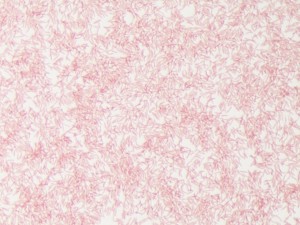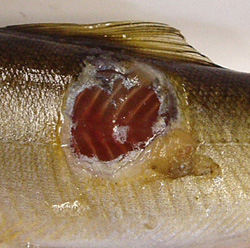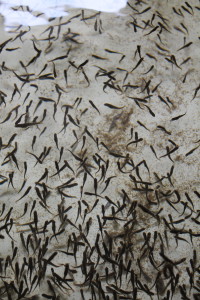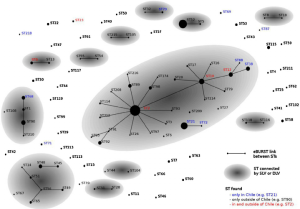I would like to introduce today a serie of articles which will explain my work in biology and make it intelligible to curious visitors without necessarily being specialists. For this first post, I will talk about the work we published in December 2015 on flavobacteriosis. Before I talk about it, I start with the context of work.
Switching from plant biology to ichthyopathology
Since 2012, I had the opportunity to change my research topic and move from plant biotechnology and improving the qualities of the fruit to animal microbiology, ichthyopathology (or study of fish diseases). This conversion seemed quite surprising for those who know me : I quickly specialized in plant biology during my initial training and had always worked on lettuce, tobacco but ultimately on tomatoes.
These topics seem apparently diametrically opposed but not so much : yes, I’m a « vegetalist » but above all I’m a molecular biologist and molecular biology is practiced in much the same way if one works on tomato, viruses, bacteria, human or pangolin. I would even say that it is a bit more complicated to work on plants and that extracting rainbow trout nucleic acids when you used to extract RNA from strawberry leaves is as difficult as reconverting yourself as a security agent in a nightclub of a quiet town in Massachusetts after having waged war in Vietnam : there is a tendency to bring out your heavy artillery at the slightest glitch whereas, finally, it is enough to just show up to be effective.
Welcome to the « Feed and Food » department of Bordeaux Sciences Agro
 So I was greeted at Gradignan, near Bordeaux, in a laboratory in Bordeaux Sciences Agro, the Higher National School of Agricultural Sciences of Bordeaux Aquitaine, formerly ENITA, just the school of agricultural engineers in the region. Especially in a team of the Department « Feed and Food » directed by Hervé Jacob. This department brings together several teams of professors and researchers working on a wide range of topics : probiotics that can be used in human health as well as in agriculture (from breeding to vegetable crops !), Human nutrition, meat quality and animal welfare in the broad sense (just before it passes to the pan…). Unfortunately, even if there is a dedicated space on the school’s website, the Feed and Food department does not have a proper website that allows to include at a glance all the research activities. It’s too bad.
So I was greeted at Gradignan, near Bordeaux, in a laboratory in Bordeaux Sciences Agro, the Higher National School of Agricultural Sciences of Bordeaux Aquitaine, formerly ENITA, just the school of agricultural engineers in the region. Especially in a team of the Department « Feed and Food » directed by Hervé Jacob. This department brings together several teams of professors and researchers working on a wide range of topics : probiotics that can be used in human health as well as in agriculture (from breeding to vegetable crops !), Human nutrition, meat quality and animal welfare in the broad sense (just before it passes to the pan…). Unfortunately, even if there is a dedicated space on the school’s website, the Feed and Food department does not have a proper website that allows to include at a glance all the research activities. It’s too bad.
I joined the small team led by Michel Le Hénaff , assistant professor specializing in microbiology, and then composed of Sandrine Papillon , engineer specializing in chemistry, and Alexandra Grasteau who was a doctoral student (defense in December 2015 ). My mission was then to integrate a research project about flavobacteriosis.
The problem of flavobacteriosis in trout (and other salmonid)

What is flavobacteriosis ? This is the generic name of a bacterial disease that affects some fish, either farmed or wild. The term also lacks precision since there are several species of flavobacteria that affect different ranges of fish under stress and different environmental conditions. I’ve taken care of only one of these species : Flavobacterium psychrophilum. « Flavo » means « yellow » (because these bacteria synthesize a yellow pigment, riboflavin, readily detectable when cultured); « Psychro » means « cold » and « philum » means « who loves ». The yellow bacterium that likes the cold. This bacterium discovered in the middle of the twentieth century proves to be the cause of two diseases affecting mainly salmonids (salmon, trout, char, etc.) :

The first is the Bacterial Cold Water Disease (BCWD), which affects adult fish and induces the appearance of cutaneous ulcerations that are fatal or, at least, make the fish unsaleable. This disease began to be a problem in North America in the 1980s, in wild salmonids whose offspring (eggs) were recovered for use in the food chain or for the restocking of streams. Given the rise of fish farming and globalization (which has led to the export of eggs and fishes across the Atlantic and the Pacific), the bacterium has been invited to the Old Continent and in temperate climate countries in Asia where these fish are consumed. There, in Europe, a new form of flavobacteriosis was expressed in rainbow trout (and fario trout) : rainbow trout fry syndrome (RTFS). As the name indicates, this disease affects young fish, fry. The disease infects this young fish whose immune defenses are too weak to be effective; sick, he stops feeding and dies. If the problem is not handled by the fish farmer, the losses can be significant (cases where 90% of the fish bank is affected).
Whether BCWD or RTFS, a single bacterial species is responsible : Flavobacterium psychrophilum. The latter is a species found in rivers with other species of the same genus. Opportunistic, it seems that it becomes problematic only when stress factors occur in fish : handling stress, injuries, excessive stocking density, poor pond water quality or temperature variations, etc. As the name suggests, flavobacterial seizures tend to occur when temperatures are low (with an optimum around 15 ° C).
The care of giving an antibiotic mixed with the diet (florfenicol, an analogue of chloramphenicol well known to molecular biologists), makes it difficult for fish farmers to treat diseased fish, as the latter no longer feed. The supplemental feeding then serves only to protect the rest of the fish bank against infection from neighboring fish or pond water. This solution is not the panacea : first of all it is expensive for animals that are not, but above all, the use of antibiotics is controversial. These should be used as little as possible for our animals (and for us) overuse will lead to the emergence of antibiotic resistant bacterial strains and it will be more embarrassing as F. psychrophilum is sensitive only for florfenicol.
The talent of fish farmers to save their fishes from this scourge is to combine a whole arsenal of prevention measures : hygiene measures, cleaning of ponds, disinfection of upstream waters, regular biocidal prophylactic treatments. Consumers have no idea of the treasure of technicality that must be developed to get this trout-portion or that smoked salmon fillet.

But the fight is not yet won, far from it : the disease progresses despite the measures of prevention deployed. This is not yet sufficiently known : what are the reservoirs (ie species or ecological compartments where the bacterium remains before infecting the fish) ? What is the dynamics of infection (this question implies two other ones : what are the defenses of the fish and how are they circumvented ?) What specific means of prevention can be deployed (vaccines, optimized biocidal treatments ?) is it still possible to optimize means of prevention non-specific to F. psychrophilum ? Is it possible to use prebiotic or probiotic products ? Moreover there is a need for tools to detect and quantify the bacteria, whether for the research and development of prevention strategies or simply to ensure traceability of their efficacy once they are set in fish farms. There are already many methods for monitoring flavobacteriosis, but there is always scope for optimization and/or the emergence of specific needs that the existing tools do not always allow to answer.
It is therefore to answer some of these questions that a research project has been concocted. Partly financed by European funds, the Aquitaine Region and the Interprofessional Committee for Aquaculture Products (CIPA), it involved the team of Michel Le Hénaff, the county laboratory of Pyrenees and Landes (LDPL, known formerly as the county laboratory of Landes, LD40) represented by Patrick Daniel and the aquaculture health defense group from Aquitaine (GDSAA) represented by Valérie Chesneau. And, of course, a panel of fish farmers from the Nouvelle Aquitaine region.
Reduce the vertical transmission of Flavobacteriosis by optimizing egg disinfection techniques
It’s this aspect of the « Flavo » project that I will address particularly in this note already well begun. There have been other aspects in this project, but this one has been published in the Journal of Aquaculture Research and Development :
« Evaluation of Glutaraldehyde, Chloramine-T, Bronopol, Incimaxx Aquatic® and Hydrogen Peroxide as Biocides contre Flavobacterium psychrophilum for Sanitization of Rainbow Trout Eyed Eggs » Authors : Alexandra Grasteau Thomas Guiraud, Patrick Daniel, Segolene Calvez, Valerie and Michel Chesneau Hénaff. The PDF can be downloaded here.
As usual, this article is written in English with all the technical details necessary to reproduce the experiments and to convince the readers of the conclusions we propose. Remember that my goal here is not to give you the details. Specialists will go directly to the paper and find everything they need. Here, I want to draw the broad outlines, highlight what I think are the contributions of our work and possible prospects. I would also like to point out that I am not in any way the spokesman for my co-authors or for the institutions mentioned above. Consider all this as a discussion around a drink or a coffee in which you would ask me what I have been working on in recent years or, in this case, what my latest publication is about.

Let’s go back to flavobacteriosis. This disease is transmitted in two ways : horizontal transmission, that is, by contact between one individual and another, directly or by contaminating the environment, especially pond water, sediments, and so on… (by analogy with humans, it may be a kiss, a sneeze, a contaminated door handle, etc.) and vertical transmission, i.e. the transmission of a genitor to its offspring (the equivalent for human would correspond to the transmission of HIV from mother to child). The international spread of the disease was made possible because of the ability of F. psychrophilum to be transmitted vertically : taken from a location A, the eggs of an infected progenitor were used for breeding which is process in a location B, contaminating other fishes which themselves have given an infected offspring transferred to a location C, etc. The movement of fish (natural or via human activity) and the alternation of vertical and horizontal transmission have allowed the spread of the disease in all the countries who produce salmonids. The study of the evolution of certain genes of Flavobacterium psychrophilum seems to demonstrate that F. psychrophilum spread in this way, step by step, from parent to offspring, sharing strains that evolved continuously. Other studies of vertical transmission show the reality of this hypothesis : the adult female is a healthy carrier (its immune defenses allow it to survive) and the bacteria present in its abdominal cavity are transmitted to the eggs during the long phase preceding laying. The bacteria survive until hatching and infect the young larva (the small fish obtained after hatching is called larva, later the larva will become fry then adult trout), the epidemic then triggering locally when the conditions become favorable.
Since flavobacteriosis is not the only disease transmitted by eggs, fish farmers are already attempting to prevent the vertical transmission of various diseases through egg disinfection and the manual elimination of affected eggs (which can change color when they die). These prevention measures are not all adapted to flavobacteriosis. Firstly, the presence of F. psychrophilum in eggs does not harm them, they survive and show no particular symptom that could allow the fish farmer to identify and remove them manually. Then, the disinfectant treatments used today have mostly been developed to prevent other diseases (bacterial, fungal, viral ?). The most common treatment is based on the disinfecting properties of povidone iodine (or other similar iodophores). You probably know this molecule since it is nothing but Betadine, which is a kind of polymer molecule on which are bound iodine molecules that carry the disinfectant power and which are released little by little into the middle ; without this system, the disinfectant power of iodine would be too fleeting and unstable. Unfortunately, current treatments (in terms of concentration and in terms of contact time) are not aggressive enough to affect lasting Flavobacterium psychrophilum and prevent its transmission to the offspring.
During our work, we focused our attention on other disinfectant molecules, a dozen of the products potentially usable by fish farmers. Among them, the most notable are florfenicol (antibiotic used to treat fish) or sodium chloride (table salt is toxic for F. psychrophilum… and trout) but especially five candidate molecules as bronopol , glutaraldehyde, hydrogen peroxide, peracetic acid and chloramine. These molecules were ultimately chosen because their anti-flavobacterial properties were poorly identified and/or because they were promising (hydrogen peroxide and peracetic acid are harmless to the environment or glutaraldehyde which is potentially very toxic to the bacterium).
One of the methods commonly used to determine the disinfectant power of a molecule is to determine its Minimum Inhibition Concentration (MIC) by adding a candidate molecule in an increasing concentration in a bacterial solution and observing its growth. If the bacterial culture continues to grow at such a concentration of disinfectant, it is because it is not sufficiently concentrated; If the bacterial culture does not grow, the concentration of disinfectant is sufficient. The lowest disinfectant concentration with the ability to block bacterial growth determines the MIC. Pretty on paper but this method involves a long contact time, several days, which does not correspond to the reality of the disinfectant treatments operated by the fish farmers (a few minutes to an hour, the eggs needing oxygen, they can’t survive without water renewal). While a disinfectant is sufficiently concentrated to inhibit bacterial growth over several days, one suspects that the bacterial population is destroyed before the disinfectant molecule is naturally degraded. However, due to the lack of information concerning the persistence of the disinfectant and the contact time necessary to destroy the bacterial population, we have chosen to propose an alternative method for estimating the anti-flavobacterial power of our panel of disinfectant products.
To determine the bactericidal power, we used a method based on sterilization schedules in industrial engineering : expose a population of F. psychrophilum to a disinfectant at a given concentration and follow the evolution of this population during a limited and known time (up to 40 min in our case, the upper range of disinfection durations allowed by fish farmers). This experiment gives us for each concentration the time necessary to decimate the population (to reduce a population to 1/10th of what it was initially), this is called « decimal reduction time ». This allows us to propose a set of correspondences between treatment time and disinfectant concentration in order to obtain the same degree of destruction. It could of course be argued that the decimation of a bacterial population is far from being a complete disinfection, but the figures we have obtained seem to indicate that the processing intensities used in fish farming were below what is necessary to if only decimate populations of F. psychrophilum. Before determining treatment intensities required to reduce a population of F. psychrophilum a factor of 100 or 1000, it seemed more appropriate to test different treatment intensities on the viability of trout eggs.
For this, we made a very simple experiment : for each of the disinfectants of interest, we settled on a treatment time of 20 minutes corresponding to what is practiced in the field and chose three different concentrations : a suboptimale concentration closed of that currently used in the industry, a concentration which corresponds to the intensities of treatment which we have previously determined and an exaggeratedly high concentration which we thought to be deleterious for the trout eggs. After treatment, we let the eggs develop and, after hatching, let the larvae become fry and begin to feed. The aim of the game is to be able to observe any malformations.
The result is that the trout eggs are incredibly resistant : they have of course survived the weakest treatments (already known for their safety against eggs since used in the profession), the new treatment conditions but also the most violent intensities of treatment. Only one disinfection treatment performed with glutaraldehyde still had a negative impact ; a result to be weighed since I suspect that the effectiveness of the post-disinfection rinse improves the survival of the eggs. If we had to expect a 10% lost for the eggs with a violent but punctual treatment to reduce the subsequent prophylactic treatments and but completely abolish flavobacterial transmission, it could be worth the money, no ? But it remains to be proved, it is only a personal opinion. However, other highly concentrated disinfectants do not affect the survival of the eggs and do not cause malformation or weight variation (which is not indicated in the article but has been verified). This is interesting for the profession, which now knows that they benefit from a greater margin of maneuver (technical if not administrative) for these disinfection treatments with substances not harmful to the environment such as hydrogen peroxide or peracetic acid.
The less obvious but no less interesting accomplishments of this work
If the main results are the development of more effective and safe anti-flavobacterial treatments for eggs and subsequent fry, I would now highlight three points of research that I find interesting.
- The more trivial it is the realization of incubation compartments for eggs and fry. They haven’t been bought somewhere but rather imagined and built by Michel Le Hénaff and Alain Rives from Bordeaux Sciences Agro. Based on the dimensions of a model used in fish farming, they ensure optimal water flow and can hold 200 which eggs/larvae in each compartment knowing that each incubation device contains six compartment. This very usefull device has allowed us to test an optimal number of repetitions in a reducted space and in similar conditions : we got a better reproducibility during our experimentation in fish farm without taking an excessive space in this said farm. This is not an empty word when we consider that the participation of fish farms have been done on a voluntary and benevole basis. It could be a pity that such a device does not benefit to the community in other types of experimentations.
- The other achievement is the EMA-qPCR viability test that we have developed to monitor the survival of Flavobacterium psychrophilum exposed to various biocidal treatments. We did not invent the technique, far from it, it dates from at least 2006, but the setup was hard and I’m better positioned to talk about it because I realized it as well as the subsequent assays. This technique uses ethidium monoazide (EMA). This molecule is an intercalant that binds to DNA. Activated by a strong luminous intensity, it is permanently fixed to the DNA then cleaves it. If this property is combined with the fact that this molecule does not penetrate into healthy cells, it can be used to distinguish dead cells from living cells : if the cell is alive, the EMA does not enter the cell and its photo-activation has no impact, the DNA of the living cell remains detectable once it has been extracted. If the cell is dead or dying, the EMA enters the cell, binds to the DNA and the photo-activation leads to the degradation of the DNA that can no longer be detected. We have used well known PCR techniques that specifically detect and quantify F. psychrophilum DNA. We were criticized for not using a traditional quantification method of putting bacteria in culture and counting them. Especially since the sophisticated technique we used is more expensive. It is a debate of fifteen years now, the techniques of enumeration are robust and inexpensive and, although I’m a molecular biologist and rather inclined to use techniques always more innovative, I’m very sensitive to this kind of argument. But in practice, once developed, this technique of EMA-qPCR makes it possible to simultaneously manipulate a large number of small samples under the same conditions and to have the results for a disinfectant in the day. The protocol may potentially be adapted to quantify viability in somewhat particular cultures such as biofilms where the proportion of cultivable/non-cultivable bacteria is not necessarily ideal for conventional enumeration techniques. This technique seems promising, the only black spot is the need to do a fine tuning to each bacterial species tested.
- The last interesting point of this work, besides the contributions for the fish farm, is the use of these famous sterilization scales, the determination of these decimal reduction times. It is used in the industrial environment for the development of methods of sterilization by heat for example. Or for enzymology, the preservation of the nutritional qualities of food products during their processing. Something quite exotic in the midst of ichthyopathology : a review article has recently been published on the various techniques and margins of optimization of techniques of disinfection of eggs and it does not emerge that this method of objectification of disinfectant properties of a chemical is particularly used or even known. Beyond this set of correspondences Duration of treatment/Concentration of biocide usable for fish farmers, this system gives us access to another value rather abstract at first sight but not devoid of interest : the value Z also called « parameter of thermoresistance specific to a microorganism ». In our case, this value could be called the « parameter of chemoresistance specific to a microorganism » (or one could continue to call it the value Z ?). Concretely, this value corresponds to the increase in concentration necessary to reduce the exposure time by 90% or to be 10 times more effective in the disinfecting power. Here is a fictive example : if we have a Z value of 100 g/L for a mysterious powder which destroys 90% of a yeast suspension in 40 min using 200 g/L, this means that if we increase this concentration by 100 g/L (= the Z value) so that the concentration is increased to 300 g/L, 90% of the yeasts are destroyed in 4 min instead of 40 min or 99% of the yeasts are destroyed in 40 min instead of 90%. Conversely, if the concentration of the powder is reduced to 100 g/l, it is known that it will take 400 min (~ 7 h) to remove 90% of the yeasts or, in 40 min we could have eliminated only 9%. This parameter Z being specific to a biocide and to a microorganism, it can also be exploited in two ways : for a given microorganism, it makes it possible to compare the disinfecting power of different molecules. Thus, in the article, it is shown that Incimaxx (peracetic acid) is much more aggressive than hydrogen peroxide whereas they both function in the same way on the bacterium. The corollary is that it also means that if you make a little mistake making the hydrogen peroxide solution, it will have less impact than by handling Incimaxx. The other utility of this data is rather for research : for a given disinfecting molecule, one can compare the chemoresistance of different microorganisms or even several strains of the same species (eg. a F. psychrophilum strain isolated in royal salmon, a strain isolated in ayu, another on rainbow trout, etc.). This would allow us to phenotype these strains, that is, to describe the specific characteristics of a strain. As with the genetic typing (genotyping), this kind of information serves to better understand the evolution of an organism and its adaptation to its environment and its host. Better understand the pathogen to better fight it. And all these « sterilization scales » can be useful for diseases other than flavobacteriosis in fish, but it can also be used for human health, agri-food, oenology, herbicides and so on. Any study to characterize the impact of a factor/treatment on a population (eg. impact of the installation of a software on a computer park on the prevalence of viruses/spyware, comparison of the impact of prevention campaigns on the prevalence of smokers or road accidents, etc.). Out of my field of expertise, I suppose that methods of objectivation of the same kind are used in one way or another…
To conclude on this post that begins to be longer than the original article. I hope I have achieved the main goals that I set myself : explain my job to my more or less close surroundings (family, friends, former colleagues or various contacts) in a sufficiently precise manner with the risk to produce a rather dense text, make visible our research (i.e. both explain the content of my CV and expose the work of this team of Bordeaux Sciences Agro) and can bring the light on certain aspects of fish farming, to which farmers may face and how research can meet some of their needs. I should mention that these works are indeed applied research, these are preliminary experiments, not industry practice consisting in flooding the rivers of France with hectoliters of glutaraldehyde… I specify once more than this article is not an infomercial in the aquaculture sector or even Bordeaux Sciences Agro…
In the future, I would do the same type of item on my previous work (PhD, post-doc) with a limitation is that I can not discuss precisely about unpublished work (and there are quite a few from 2005 to 2016). The Flavobacteriosis project is wider than disinfection treatment, there have been other results that we are still working on or that are exploited in other ongoing projects. As we say it in french : I can’t go faster than the music…